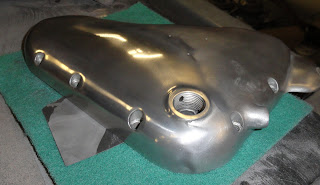Today the mounting surfaces of the head were faced on a granite block with sand paper glued to it - using 80 grit.
The 2 engine casings were washed in parrafin to get rid of greasy residue, then high pressure blasted to make sure there was no residuel grit in the bearings, and then the studs were put in.
The new valve guides were pressed into the head, and they were lightly laped to ensure the valve fitted smoothly. Then the seats where cut. Then valve seat grinding began, this is quite a lengthly process requiring valve grinding paste and a suction cup, then spinning the suction rod between your palms to grind the valve seat, after a while it is then checked with blue marking paste to check where the seat is resting - and then the process resumes until there is a perfect seat the whole way round.
 |
| Valve guides about to go in |
 |
| Sanding the guides slightly |
 |
| Valves assigned to there positions and numbered |
 |
| Cutting the valve seats |
 |
| Grinding the valve seats for a perfects "fit" |
 |
| Checking with marking blue to make sure the seat is all round - this one needs some more grinding! |
The ali. covers had there bolt head holes opened up by ,5 mm to take the new case bolts, had a final polish and then were washed in thinners to get rid of any polishing residue, they are now ready for clear painting.
The gear box gears and parts were vapour blasted and oiled to prepare them for the re-assembly of the gearbox.
The oil release valve was taken to pieces, vapour blasted and then re-assembled, the small piston was stuck inside, but after some persuation released and moved freely. Then the valve was re-assembled.
The cam follower guides were pressed into the barrel and there locating nuts put in place, then the cams were located.































































